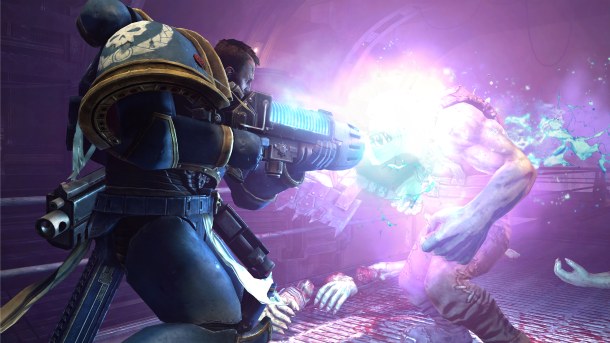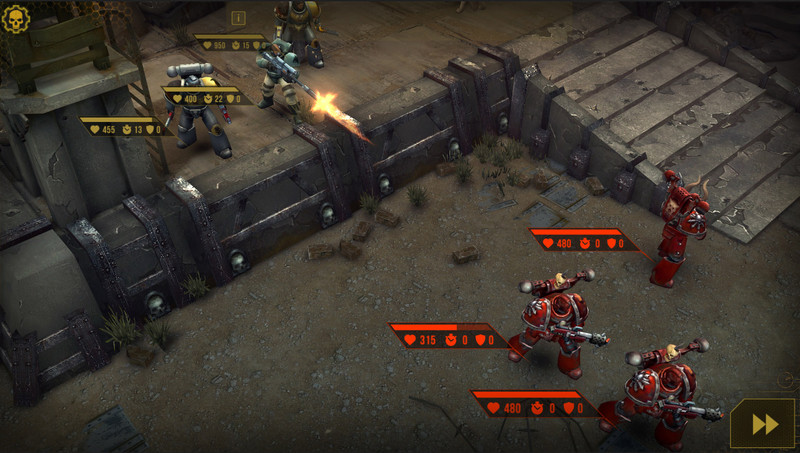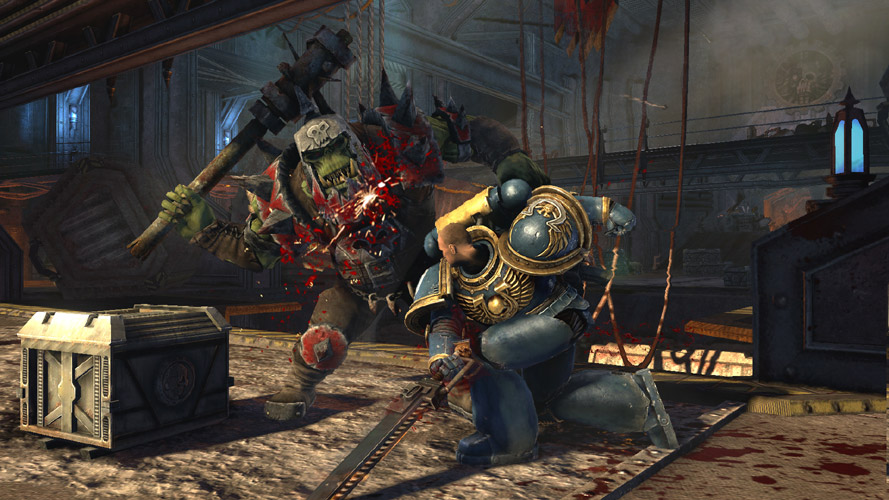Games Workshop’s Warhammer 40,000 (or just 40K) is one of the most sprawling and detailed science fiction universes ever created. In the 41st Millenium, Earth is memory, and giant mutant superhumans preserve the legacy of Humankind throughout a hostile galaxy full of aliens and demons that really don’t like us. The image of giant hulking, mega armored Space Marines was born in this lore, even if it would be Blizzard’s Starcraft who would popularize the trope in video games to come.
40K has a rather long history with video games. Not all of it is great. In fact, most of it is well outdated and basically unplayable compared to modern standards. Still, a definitive list of these games must be written, so that when we make first contact, aliens know what to avoid. Aliens, and people who are looking to get into 40K games, of course.
You’ll notice this list is missing a couple of games. Glory in Death was an N-Gage title, and I never played it. Eternal Crusade is an upcoming MMO that I don’t have beta access to. I haven’t yet played Carnage for the iOS, and I hadn’t even heard of Final Liberation before I started my research for this piece.
To the list then:
11. Rites of War
Rites of War is really bad. Made with SSI’s old Panzer General engine, the blocky, hex-based turn-taking lacked any real strategy to speak of. Different units shot at different ranges and moved at different paces, but the end result was always, “fly forward and shoot whatever is in front of you.”
It is one of the few 40K games that puts you in the shoes of a non-Space Marine in its main story. The Eldar—essentially space elves—take front and center, and though it’s based on an interesting premise, the story falls flat on its face rather quickly. It’s also butt ugly. Leave this deep cut alone.
10. Storm of Vengeance
An incredibly bland lane-strategy game, there is almost no reason to pay the entry fee to take this ride, no matter how cool you think the Dark Angels chapter is. And if you don’t know names like Ghazghkull, Thraka or Belial, then move right along. There’s nothing to see here.
9. Space Hulk
Space Hulk tends to have a very sacred place in a lot of old 40K players’ hearts, as it’s a direct adaptation of the board game of the same name, which was one of the first instances of the Games Workshop license moving outside of the tabletop space. When it was remade last year, a lot of the revisionist history about the game’s merits started to get cleared up. In changing very little about the old formula, Full Control ApS helped shine a light on all the things that made that game not so great.
As a squad of Terminators – bigger Space Marines with more intense weaponry and more extreme prejudice towards other living things – you’re tasked with navigating the narrow corridors of a ship infested with Tyranids, the Zerg-like bug alien world eaters. Being gigantic, you can only move down halls single file, and you can’t shoot past the friendly in front of you. The game became a slow paced exercise in wedging a squad mate into a door frame and waiting in overwatch while the enemy piled in. The formula gets old quick and never changes, making a person whom has finished Space Hulk both a saint and a masochist.
8. Kill Team
A two player co-op twin stick shooter that sharts you into a Ork warship, and tasks you and a partner to get all Tango and Cash on the greenskins. You can choose between different types of marines: a magic wielding Librarian, a heavy weapon toting Devastator, etc. It won’t matter, though. These weapons pretty much perform the same across the board, no matter whose hands they’re in.
Enemies come in all shapes and sizes, but are dispatched with little to no effort save for pointing the stick in their direction and letting bullets erode them away. Good for a cathartic power trip, but nothing else.
7. Space Wolf
A gorgeous game for mobile devices that takes interesting concepts and does absolutely nothing with it. Instead of attempting to gain tactical advantages over your opponents, you rely heavily on being able to out-damage them with overpowered cards, which take the form of weapons and abilities. You’ll never get an opportunity to gain these cards naturally, though. Unless you’re willing to open your wallet to buy packs or in-game currency to level up abilities and characters, you will struggle to see any reason to play this game.
Asking for money for a game is fine, but charge it up front. Don’t make the balance of the game depend on it.
6. Fire Warrior
This is a very divisive game amongst players. Fire Warrior is either a game you appreciate for its well staged action set pieces and its attempt to tell a non-Human centric story about one of the brand’s most interesting races, or one you hate for its antiquated, basic-bitch shooter mentality (and this was back in 2003). The AI was absolutely atrocious, as enemies would almost appear as if they were allergic to taking cover, each little bullet an epipen to cure them of the disease of making the right decisions. It also does its best Doom impression, making you backtrack and collect colored key for doors in order to move on. Remember, this was 2003.
Even with a former Doctor (Who?) on voice work for the main character, there’s really not much saving this game.
5. Chaos Gate
Not the first 40K video game, but maybe the first of note, Chaos Gate was a turn based strategy game that really solidified the mold that many 40K games in the genre would be cast in. Grid based movement, action points, it’s all here. There’s also a surprising amount of RPG elements, allowing you to customize individual members of of your squad to fit different roles. When marines died, they stayed dead, which only made later missions that much harder.
People remember the music as one of the games’ stand out features, which may be true. The Latin chorus did provide that “epic” feel. The rest of the sound design was incredibly bad, and Chaos Gate was prone to some of the wonkiest bugs in the franchise. The story was also quite boring, an unfortunate characteristic of many 40K games. Still, there’s no denying it’s role as progenitor of a turn based formula 40K games would stick to for years to come.
4. Squad Command
Like almost every other Warhammer 40K game, this title has a really hard time telling a story anyone cares about. Squad Command ultimately succeeds where other turn based outings from the license previously (and continue to) fail is making the gameplay feel more like the tabletop game than ever before. Action points still determine what a unit can do and how much of it can be done, but movement isn’t restricted by grids. When a unit is done moving, it can target anything in its front arc, and can add remaining action points to a shot to make it more accurate. There were partial negatives for shooting in crowds or at units behind obstacles, something that sounds like a no-brainer in a ranged-heavy strategy game, but nowhere near reality in the scope of 40L games.
Enemy types were not very diverse; there were no vehicles, and customization was relatively limited, but the game showed incredible potential. It’s was trapped on handhelds, though, and never truly got the sales needed to justify a sequel to expand on the formula.
3. Space Marine
Not only was Space Marine the first real action-centered title in the long history of 40K games, but it was a competent one, at that. As Captain Titus of the Ultramarines, you and a boy band of big blue badasses are sent to cancel an Ork invasion on an Imperial planet. Once you get there, of course, you find that things aren’t as they appear.
The story is basic, but well paced and pretty admirably acted; really the first time I can say that confidently about any 40K title. The world is damn pretty, too. Action is straight-forward, but shooting feels good, and the game was designed around the one big third person action game trope its unabashedly missing: cover. Space Marines don’t take cover, after all, and instead of ducking behind a rock to gain back some health and refocus your plan, you’re tasked with executing the enemy in order to stay in the fight. This was a clever work around that demanded aggression from you, and pushing the action is exactly what gives this game legs when compared to other B-list action games. With THQ sinking, there’s no telling if it will ever get a sequel.
2. Dawn of War
Relic really turned heads with this one back in 2004. Not only was it finally a 40K game people who don’t play 40K may actually respect, is was a competent and intuitive real time strategy game on its own merits. Very much rooted in the soil nurtured by RTSs before it, Dawn of War finds a way to make the Starcraftian hustle and bustle of resource management and base building seem unique. You don’t mine or harvest gas, but more like capture and control important strategic points, that slowly add currency to your coffers.
It was incredibly well detailed, too. When units met each other in battle, it could almost be distracting, because the animations were so intricate and brutal that you’d find yourself more interested in watching the skirmish than commanding your force. Multiplayer was an absolutely blast as well, capitalising on the fact that resources were out in the open and not always in a place you could build a base on; conflict was always around the corner.
It had its problems. Maps were full of winding paths that the AI had a tough time finding the quickest route through on their own. Some units couldn’t pass through spaces they probably should have (like Predator tanks and Dreadnoughts), and others were just blatantly overpowered (Grey Knight Terminators). All in all, though, this was the first “must play” 40K game.
1. Dawn of War II
The second “must play” 40K game, Dawn of War II, was a dramatic change from the first, and is one of the smartest attempts at re-calibrating the old RTS design in recent memory. Removing the base building emphasis, and adding a helping of RPG elements makes for a very unique relationship the player will build with this game. Each unit type is lead by a captain, who has a name and opinions. You can upgrade them with new weapons and armor, which in turn can enhance the effectiveness of their troops. In the single player campaign, these characters grow and enhance, becoming full fledged party members not unlike your favorite PC RPGs.
In combat, the cover system is expanded greatly, putting more emphasis on where each individual in a unit is, and not just the whole glob. Environments are incredibly destructible too, leaving the threat of suddenly being out in the open a nagging feeling in the back of your thoughts. This focus on smaller group organization really helps this game become way more tactical than RTSs are known for. Your moment-to-moment decision making process has far more variables now, and may be a closer analog to the table top game’s sense of speed and pace than even Squad Command.
In multiplayer, it begins to resemble a normal RTS a little more, as you actually have to produce captains and their squads, and their loadouts aren’t as dynamic. But each of the four present races offer a unique take on this more personal design that is refreshing and hard not to recommend.

















